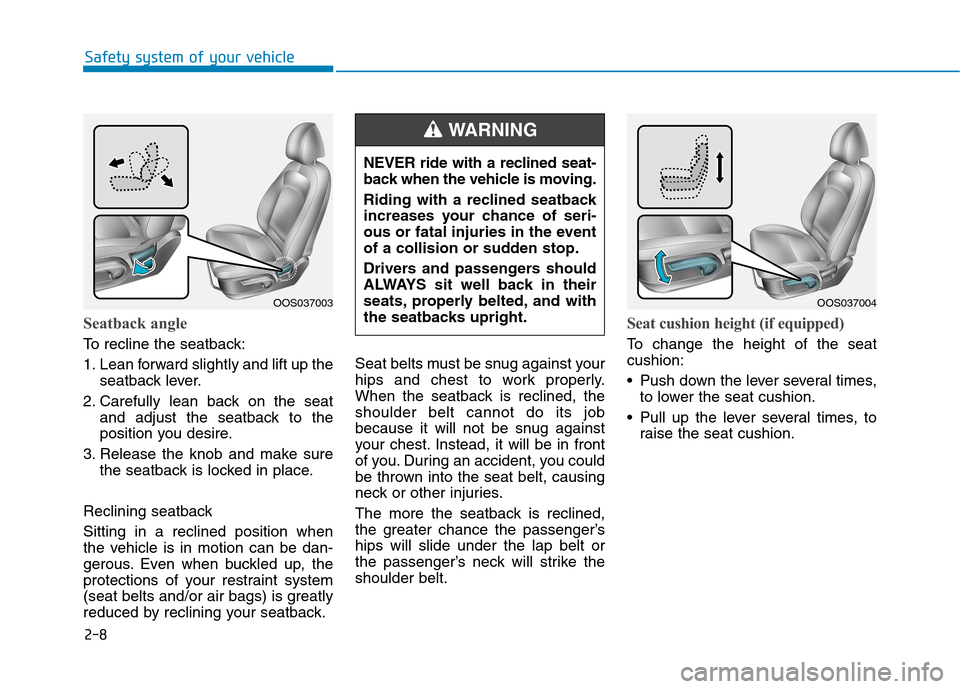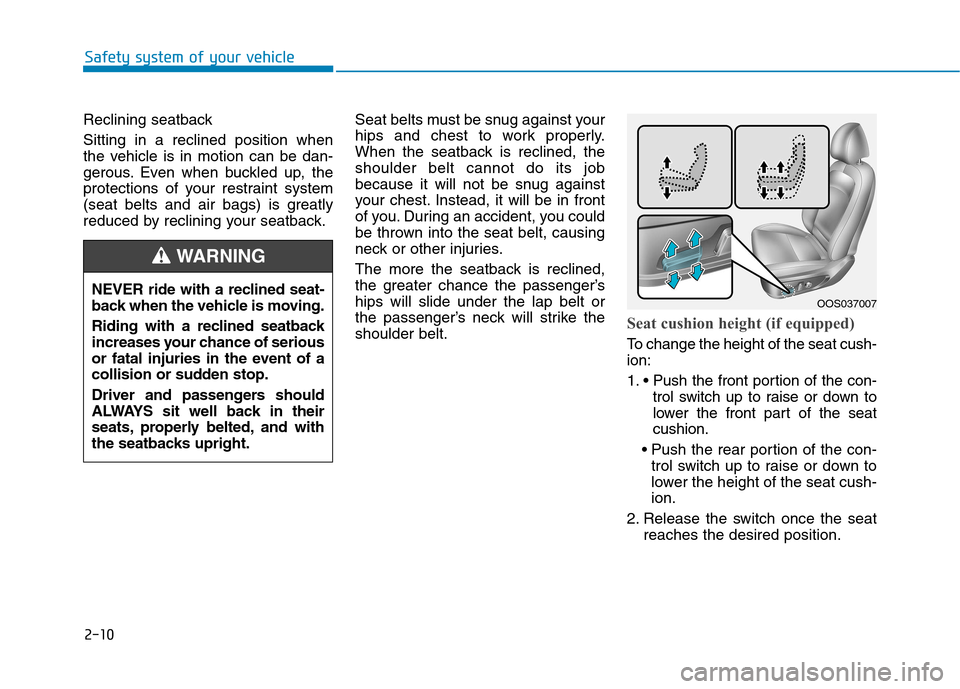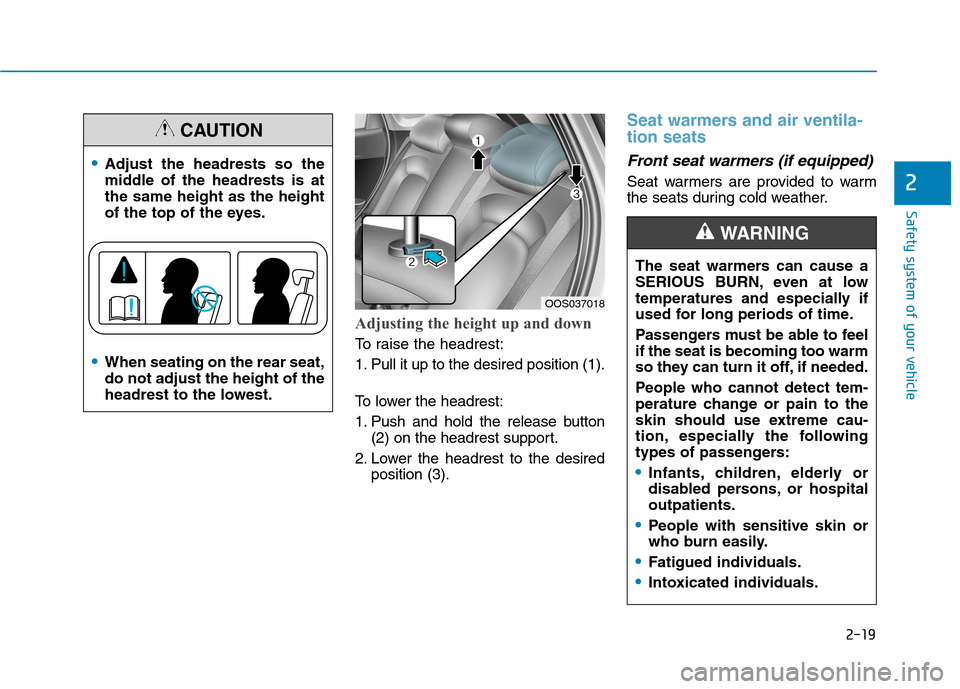Page 23 of 523
2-4
SSEE AA TTSS
Safety system of your vehicle
OOS037073
Front seat
(1) Forward and backward
(2) Seatback angle(3) Seat cushion height *
(4) Lumbar support (Driver’s seat)*
(5) Seat warmer*/Air ventilation seat*(6) Headrest Rear seat
(7) Armrest*
(8) Seatback folding(9) Headrest
* : if equipped
[A] : Driver’s Side, [B] : Rear seat
■
Left-Hand drive type
Page 24 of 523
2-5
Safety system of your vehicle
2
OOS037001R
Front seat
(1) Forward and backward
(2) Seatback angle(3) Seat cushion height *
(4) Lumbar support (Driver’s seat)*
(5) Seat warmer*/Air ventilation seat*(6) Headrest Rear seat
(7) Armrest*
(8) Seatback folding(9) Headrest
* : if equipped
[A] : Driver’s Side, [B] : Rear seat
■
Right-Hand drive type
Page 27 of 523

2-8
Safety system of your vehicle
Seatback angle
To recline the seatback:
1. Lean forward slightly and lift up theseatback lever.
2. Carefully lean back on the seat and adjust the seatback to the
position you desire.
3. Release the knob and make sure the seatback is locked in place.
Reclining seatback Sitting in a reclined position when
the vehicle is in motion can be dan-
gerous. Even when buckled up, the
protections of your restraint system
(seat belts and/or air bags) is greatly
reduced by reclining your seatback. Seat belts must be snug against your
hips and chest to work properly.
When the seatback is reclined, theshoulder belt cannot do its job
because it will not be snug against
your chest. Instead, it will be in front
of you. During an accident, you could
be thrown into the seat belt, causing
neck or other injuries.
The more the seatback is reclined,
the greater chance the passenger’ships will slide under the lap belt or
the passenger’s neck will strike theshoulder belt.
Seat cushion height (if equipped)
To change the height of the seat cushion:
Push down the lever several times,
to lower the seat cushion.
Pull up the lever several times, to raise the seat cushion.
OOS037003 NEVER ride with a reclined seat-
back when the vehicle is moving.
Riding with a reclined seatback
increases your chance of seri-
ous or fatal injuries in the event
of a collision or sudden stop.
Drivers and passengers should
ALWAYS sit well back in their
seats, properly belted, and with
the seatbacks upright.
WARNING
OOS037004
Page 29 of 523

2-10
Safety system of your vehicle
Reclining seatback Sitting in a reclined position when
the vehicle is in motion can be dan-
gerous. Even when buckled up, the
protections of your restraint system
(seat belts and air bags) is greatly
reduced by reclining your seatback.Seat belts must be snug against your
hips and chest to work properly.
When the seatback is reclined, theshoulder belt cannot do its job
because it will not be snug against
your chest. Instead, it will be in front
of you. During an accident, you could
be thrown into the seat belt, causing
neck or other injuries.
The more the seatback is reclined,
the greater chance the passenger’ships will slide under the lap belt or
the passenger’s neck will strike theshoulder belt.
Seat cushion height (if equipped)
To change the height of the seat cush- ion:
1.
trol switch up to raise or down to
lower the front part of the seatcushion.
trol switch up to raise or down to
lower the height of the seat cush-ion.
2. Release the switch once the seat reaches the desired position.
NEVER ride with a reclined seat-
back when the vehicle is moving.
Riding with a reclined seatback
increases your chance of serious
or fatal injuries in the event of a
collision or sudden stop.
Driver and passengers should
ALWAYS sit well back in their
seats, properly belted, and with
the seatbacks upright.
WARNING
OOS037007
Page 34 of 523

2-15
Safety system of your vehicle
2
Headrest
The vehicle’s front and rear seats have
adjustable headrests. The headrests
provide comfort for passengers, but
more importantly they are designed tohelp protect passengers from whiplash
and other neck and spinal injuries dur-ing an accident, especially in a rearimpact collision.To prevent damage, NEVER hit orpull on the headrests.
NOTICE
To reduce the risk of serious
injury or death in an accident,
take the following precautions
when adjusting your headrests:
Always properly adjust the
headrests for all passengers
BEFORE starting the vehicle.
NEVER let anyone ride in a seat
with the headrest removed.
Adjust the headrests so the
middle of the headrest is at thesame height as the height of
the top of the eyes.
NEVER adjust the headrest
position of the driver’s seat
when the vehicle is in motion.
Adjust the headrest as close
to the passenger’s head as
possible. Do not use a seat
cushion that holds the body
away from the seatback.
Make sure the headrest locks into position after adjusting it.
WARNING
OLF034072N
When there is no occupant in
the rear seats, adjust the height
of the headrest to the lowest
position. The rear seat headrestcan reduce the visibility of therear area.
CAUTION
Page 35 of 523
2-16
Safety system of your vehicle
Front seat headrests
The driver’s and front passenger’s
seats are equipped with adjustable
headrests for the passengers safety
and comfort.
Adjusting the height up and down
To raise the headrest:
1. Pull it up to the desired position(1).
To lower the headrest:
1. Push and hold the release button (2) on the headrest support.
2. Lower the headrest to the desired position (3).
Forward and rearward adjustment
(if equipped)
The headrest may be adjusted for-
ward to 3 different positions by
pulling the headrest forward to the
desired detent. To adjust the head-
rest to it’s furthest rearwards posi-
tion, pull it fully forward to the farthestposition and release it.
OPDE036068
OOS037061OOS037010
Page 37 of 523
2-18
Safety system of your vehicle
To reinstall the headrest :
1. Recline the seatback.
2. Put the headrest poles (2) into theholes while pressing the release
button (1). 3. Adjust the headrest to the appropri-
ate height.
4. Recline the seatback (4) the seat- back angle knob or switch (3).
Rear seat headrests
The rear seats are equipped withheadrests in all the seating positions
for the passenger’s safety and com-
for t.
OPDE036069
Always make sure the headrest
locks into position after rein-
stalling and adjusting it properly.
WARNING
OOS037013
OOS037014
■
Type A
■Type B
Page 38 of 523

2-19
Safety system of your vehicle
2
Adjusting the height up and down
To raise the headrest:
1. Pull it up to the desired position (1).
To lower the headrest:
1. Push and hold the release button(2) on the headrest support.
2. Lower the headrest to the desired position (3).
Seat warmers and air ventila- tion seats
Front seat warmers (if equipped)
Seat warmers are provided to warm
the seats during cold weather.
The seat warmers can cause a
SERIOUS BURN, even at low
temperatures and especially if
used for long periods of time.
Passengers must be able to feel if the seat is becoming too warm
so they can turn it off, if needed.
People who cannot detect tem-
perature change or pain to the
skin should use extreme cau-
tion, especially the following
types of passengers:
Infants, children, elderly or
disabled persons, or hospitaloutpatients.
People with sensitive skin or
who burn easily.
Fatigued individuals.
Intoxicated individuals.
WARNING
OOS037018
Adjust the headrests so the
middle of the headrests is atthe same height as the height
of the top of the eyes.
When seating on the rear seat, do not adjust the height of the
headrest to the lowest.
CAUTION